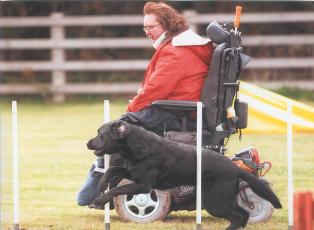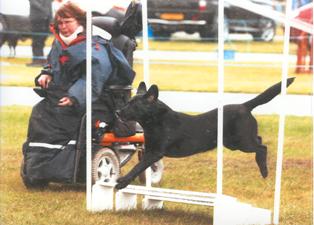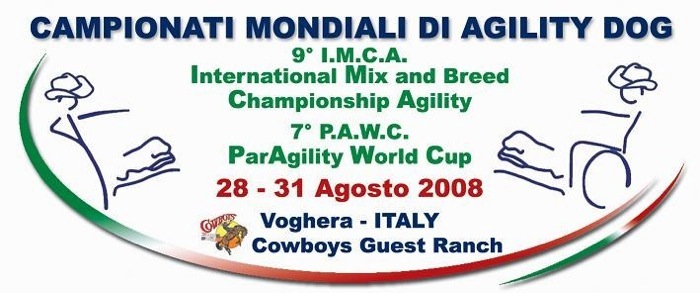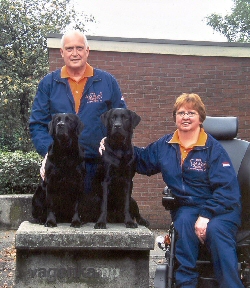Crossing the Channel to compete
 A
lot of preparation went into Susan Rekveld's journey to England! She travelled all the way from
The Netherlands to Cornwall to take part in the K9 Easter show at Wadebridge. To find a hotel
which has a specially adapted room for wheelchair users which also accepts two dogs - even
service dogs - was not easy, but accomplished! Her mission was to make contact with other
disabled handlers to encourage them to take part in the 7th ParAgility World Cup in Italy in
August and, of course, to run dogs. A
lot of preparation went into Susan Rekveld's journey to England! She travelled all the way from
The Netherlands to Cornwall to take part in the K9 Easter show at Wadebridge. To find a hotel
which has a specially adapted room for wheelchair users which also accepts two dogs - even
service dogs - was not easy, but accomplished! Her mission was to make contact with other
disabled handlers to encourage them to take part in the 7th ParAgility World Cup in Italy in
August and, of course, to run dogs.
Due to the fact that I am confined to
a wheelchair, my dogs and I seemed to a few more obstacles to take compared to regular
handlers.
First I needed
Authority to Compete (ATC) numbers for my dogs from the Kennel Club. I applied, paid by
internet and received them just one week later by post.
On
Wednesday 19 April, my husband Leon, our two black Labrador Retrievers Quita (8) and Joep (3)
and I started our journey from the Netherlands to England, staying overnight t in Calais (
France). The next morning we came to the first the international control point for the dogs
where we had to present our special rabies vaccination certificates. Next we travelled by train
via the Channel Tunnel to Folkestone - only 35 minutes - and then there was another 510k to
drive to Bodmin on the left side of the road. In Europe we drive on the right-hand side of the
road, so that was very strange for us!
And then we were there
The show was
being held at the Royal Cornwall Showground in Wadebridge (Cornwall) over the Easter weekend
from Friday until Sunday, 21-23 March. First thing I wanted to do was to make contact
with a group of other disabled handlers who were attending the show. I had met Philippa
Armstrong and Ann Gill, co-founder of the Disabled Handlers Association before. In England, as
in Europe and other places around the world like the USA, Canada, and Japan, the number of
handlers with disabilities is growing. I feel very happy about this!
I was
competing with my two dogs - Quita (8) the oldest one and Joep (3) my younger one.
Joep is
a Starter so he was running
Grade 3. Every day we did an Agility and a Jumping course.
In the Netherlands,
Quita is
considered a Veteran which is seven years old plus, but in England this class is for nine years
olds plus, so she could only run Special Anysize Combination classes Grades 1-7 and that meant
she only did two Jumping classes.
For
us, it was the first agility-match after the winter so Joep was very enthusiastic - sometimes
too much so! He had a clear round but with some time faults. Quita took home a Clear
Round Rosette!
Observations
 I
noticed some differences between an agility-match between England and the Netherlands (Europe)
such as: I
noticed some differences between an agility-match between England and the Netherlands (Europe)
such as:
1.
In The Netherlands, we just start at the number 1, then go 2... 3... 4... 5... In England,
they give the possibility to start for example numbers 1 to 40.
2.
In my country, you
announce yourself. It is the judge who gives you the sign by whistle. In the UK, it is
the 'writer' (scrimer) who gives you the signal to start.
3.
What surprised me was that there were no dog walks on any of the agility courses the dogwalk
but that was probably due to the weather. In Europe, we nearly always have the three
contact-obstacles, A-frame, dogwalk and see-saw in the agility class.
4. I
really missed the electronic time display board on the fields. We always post the results of
each run.
5.
Some of the judges put in one or two traps for Grade 3 which is not always the case in
the Netherlands or Europe at this level.
6.
In my country, all competitors bring with them a little tent and seat so they can all
sit around the ring together and watch the courses. They stay close to the ring the whole
day. I didn't see that in England.
7. This match had
five rings and I've heard that agility matches in England may have as many as 12 rings or
more. In the Netherlands, our biggest shows might have 3- 4 rings.
8. The final thing
that attracted my attention was the age of the handlers. In the UK, it seems that there are
more handlers with a higher level of age which is great!
We
were not lucky about the weather. It was very cold and we had a lot of wind and rain, hail and
even a snow storm, but it was all part of the experience. It was most impressive to see
Philippa, sending her dogs through the course. I have a lot of admiration for her!
Join us
For anyone wishing more information about para-agility and the ParAgility World Cup
go to:
www.para-agility.nl

 About
the author... About
the author...
Susan Rekveld was born with a muscles disease (AMC) and has been dependent on
an electric wheelchair since the age of 30.
In 1996 she saw a
television program about dog training and decided to try agility- training with her dog Cindy,
a female black Labrador Retriever, then five years old. Susan already had some experience with
Obedience training because she had trained her dogs to assist her with picking up things from
the floor, opening/ closing doors and shopping etc.
In 2001 she entered
her first agility competition with another black Lab called Quita who has proved to be very
capable for dog sports and seems to enjoy agility very much. Then in 2002 they took part in the
1st ParAgility World Cup in Hungary and came back as Champion of the Large dogs group,
rewarding her for all their training.
In December
2004 she got her third black Labrador Joep - this time a male. In 2006 he took part into his
first agility-match in the Expo Hal in Gent ( Belgium). He was very enthusiastic, so they we
have taking part into more matches.
|